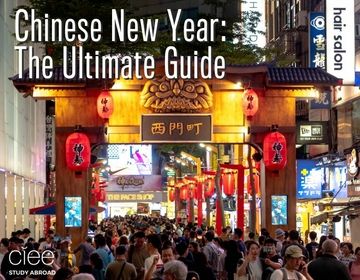CIEE Shanghai Overnight Excursion to XI’AN AND LUOYANG
By Fall 2023:
Abena = College of William & Mary ‘25 (International Relations) - ACL Program
Angela = Hamilton College ‘25 (Chinese and Sociology) - CGC Program
大家好! We are Abena and Angela, two out of our tight-knit cohort of seven this semester in Shanghai. After our midterms ended in October, we embarked on a CIEE-led trip to central China to explore the two historic cities of Xi’an and Luoyang. Here is what we did!
In Xi'an, our first stop was the ancient City Wall, a vivid symbol of the city's history as the capital of 13 dynasties and home to a total of 73 emperors. On top of the wall, it felt like we were on a wide street. We had the choice to either walk or bike, and in order to make the most out of our experience, we decided to do the latter. It was so cool to be able to explore the most preserved city wall in all of China while viewing the old city on one side, and the new on the other.
The second stop was to the world-renowned Emperor Qinshihuang's Mausoleum Site, which houses the Terracotta Army. The site was discovered in 1974 and became a UNESCO World Heritage Site in 1987. Although today there are still probably thousands of warriors that have yet to be discovered, the amount that has already been unearthed and put back together give a glimpse into the sheer size of this project. Additionally, the individuality of every soldier is striking. Depending on the armor, hand position, or hairstyle, it is possible to tell the soldier’s rank and role in the army. Personally, I (Abena) have dreamed of seeing this in real life ever since I saw a movie about them when I was young, so this was definitely one of the highlights of the trip.
Next we hopped on a high-speed rail from Xi’an to our next destination, Luoyang. Luoyang was the capital during the Tang Dynasty, and it was where Empress Wu Zetian, the only female emperor in Chinese history, ruled from. Our first activity of the day (after lunch) was the famed Shaolin Temple. Here we toured the grounds and watched a Kung Fu performance by the Shaolin monks.
We spent our next full day in Luoyang at the Longtan Grand Canyon, taking a golf cart to the top and making our hike down. The canyon was a beautiful and refreshing break from the fast-paced city we had spent the first half of the semester in. Descending down winding paths into the canyon, we saw a variety of streams, rock formations, and lush greenery, even in November. Another UNESCO World Heritage site that we visited during this trip was the Longmen Grottoes. The grottoes feature thousands of ancient Buddhist statues and caves carved into limestone cliffs.
After the planned activities of each day, we set out to explore the nightlife in both cities. In Xi’an, we walked down the bright and bustling 回民街(huí mín jiē), nestled under the Drum Tower right next to our hotel. This is the prime place to try many of Xi’an’s specialty snacks, such as 肉夹馍 (ròu jiā mó). In Luoyang, the night market we explored was inside a city wall. Upon walking into the grand entrance we were greeted with another bustling maze of shops selling small snacks and souvenirs. Not only could we try local food like 水席(shuǐ xí) and buy small gifts, but we also had the chance to talk to locals and hear more northern style accents.
Our trip to Xi’an and Luoyang was as much about learning as it was about sightseeing. Each site that we visited offered a glimpse into China’s rich history, and the tour guide that accompanied us each day made things both educational and entertaining. It was a rewarding trip to celebrate completing half the semester, and one of our most memorable experiences.
Related Posts

EAT, DRINK, EXPLORE: BEIJING
BEST FOOD TO EAT IN BEIJING Peking duck ( shāo yāzi) has been eaten in Beijing since the Imperial Era and is the city’s most famous dish to date. The... keep reading

Eat, Drink, Explore: Shanghai
BEST FOOD TO EAT IN SHANGHAI While in Shanghai, do yourself a favor and enjoy one of the city’s most popular plates: xiaolongbao (soup dumplings). These delicate steamed buns typically... keep reading

Chinese New Year: The Ultimate Guide
Red envelopes, firecrackers, and a feast that puts your college meal plan to shame – Chinese New Year is the celebration of the year, and you don’t want to miss... keep reading
